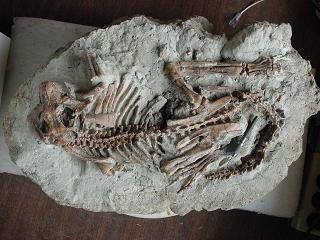exposure Preparing
When fossil bones of a dinosaur come to the lab, saws and scissors are used to remove plaster jackets. Then begins the work of extracting the bones from the rest of the rock. This can be an extremely delicate operation, and scientific teams often need several years to completely clear all the rocks and the remains of a single dinosaur skeleton. This process is known as preparation. How fossils are cleaned depends on the hardness and chemical composition of the rock.

Scientists often collect large blocks of rock, since the very rock surrounding the fossil provides added protection during transport. Sometimes the rock also contains important information about dinosaur biology, and fossilized remains of the intestine or skin tags. Once blocks have been examined, one can extract the pieces of rock that contain bone meal or any material useful with diamond saws. However, when removed lumps of rock next to fossilized bones, scientists have much more care Tehran, not as powerful tools can be used. For this work, finer needles and instruments used in dentistry. These are made of very hard metals such as steel and tungsten, and are used to separate grain by grain, the rock of the fossil bones. Peden is sometimes used "pencils Special air that allow small beads of stone detached from the surface of the fossils. These tools use compressed air to dislodge tiny particles of hard material of the rock.

acid baths
Some rock types, such as clay, they dissolve in contact with acid. In some cases, the scientists immerse the blocks of rock containing the fossil bones in tanks filled with a weak solution of acid. For this purpose acid is often used, the chemical that gives vinegar its characteristic smell and taste. The acid is slowly consuming the rock, exposing the bone in it. Be very careful that the acid begins to dilute the blood. To avoid this, sometimes you have to block out the solution to paint the surfaces of bone with a special chemical that protects against the acid.

following steps
Once the bones have been removed completely from the stone around them, they have to rebuild. Is like trying to mount a huge three-dimensional puzzle. You have to use special adhesive glues that do not contain harmful chemicals. Often, the bones are very fragile and can be damaged by rough handling, with suatancias chemical storage areas and display, or even temperature changes. On the bones apply protective chemicals to protect them from these factors. When you have completed these steps, the fossils are ready for a detailed study and exposure.
Reconstruction and exposure
Scientists tend to hold exhibitions in museums featuring dinosaurs and animals exciting and dynamic. To achieve this, the skeletons are reconstructed in real positions, so that visitors can imagine how they ran or how they fought. Special structures are built to sustain heavy metal fossil bones and keep them in the correct position. Artists working closely with scientists to help them recreate scenes from the Mesozoic to get a bottom right forum skeletons.
0 comments:
Post a Comment